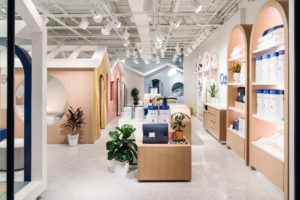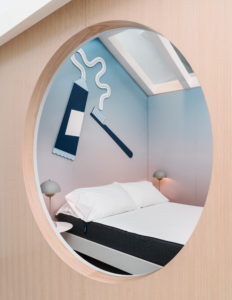Have you ever wondered how two products can seem so similar, yet one becomes a household name and the other fades to the background? Have you ever found yourself urging a friend to try a product, service or experience because you can’t stop thinking about it?
This is the power of customer-centered design.
Consider Apple, Google and Airbnb. These companies offer vastly different services, but they share a common practice. They place their customers at the center of the product experience, and they use an understanding of customer wants and needs to build beloved brands.
Chances are you first heard about them from a friend or family member who raved about an amazing trip they booked on Airbnb, the ease of “googling” something on an uncluttered site, or how the expert at the Apple Genius Bar not only saved their cracked phone but also taught them hacks for saving storage space.
There’s an endless list of competitors out there who offer similar services. So what is it about these companies who ultimately win your mindshare and the biggest share of the market?
- They’re the ones who put their customer at the center of every single decision.
- They do what is right for the customer first, and let the business model flow from there.
- They understand that no amount of marketing spend can make up for a bad customer experience.
- And they are relentless in making sure their customers know they care.
In return, they win loyalty, brand love and an army of user-promoters more powerful than the most targeted marketing campaigns.
Customer Needs in the Hands of the Decision-Makers
Mapping customer experience and designing for customers is not a new idea. What’s new is that some of the most innovative and forward-thinking companies are elevating the role of customer experience to the C-suite, positioning it alongside CEOs and CMOs with exposure to and engagement with the Board of Directors. The instantiation of this commitment is in the investment in a Chief Experience Officer.


When Magnus Olsson co-founded Careem, a ride-hailing app that serves customers across the Middle East, North Africa, India and Pakistan, he knew that in order to straddle multiple geographies and cultures, he needed to elevate customer needs to a higher level with more influence and oversight. So he hired a VP of Customer Experience and a VP of Captain Experience, two roles intended to own every step in the customer journey. But even at the VP level, it soon became apparent that this pair of executives did not have enough organizational power and influence to make the impact that was required.
He realized that the potential to build and protect brand value was contingent on recovering loyalty for those clients and drivers who had a negative first experience with Careem. He believed if he could regain their trust, he could convert them to loyal customers and partners. And while call center and customer experience employees could provide fast responses and troubleshooting on the fly, the same problems surfaced again and again.
So Olsson took on the role himself. As Chief Experience Officer, he sits at the executive table and drives decision-making cross-functionally, alongside his team. He brings the customer lens to every strategic and budget decision the company makes. He is the voice and conscience of the target customer. He’s constantly pushing to keep the bar for service high, and ensures that customers remain at the center of company strategy.


For startups, this concept often gets overlooked or pushed aside. There's budget to consider, and culture fit, and a lingering concern over too many leaders at one table. It can feel like it's "too early" or the company is "too small" to worry about this yet. Those are valid concerns, but it is becoming apparent that these considerations are trivial compared to the potentially transformative effect of this role across the entire company.
But there’s also an upside. Reaching customers means gaining loyalty, a metric with direct business impacts, according to Casper’s Chief Experience Officer, Eleanor Morgan. Casper has always prioritized creating a leading customer experience. “Our goal is to create delightful experiences that invite customers to be part of our community and engage more in sleep,” says Morgan.
Casper is on a mission to elevate the science of sleep while inspiring joy and the magic of bedtime. As they expand across new channels, including more than twenty owned retail stores and new retail partners, it's more important than ever to present a cohesive experience. “We approach all channels as if they were one store, eliminating boundaries—because the reality is they are one brand experience to the customer," she says.
In her role, Eleanor is responsible for the design and development of the Casper customer experience across channels—from digital to retail to in-home touchpoints. She leads digital product, UX strategy and design teams to create experiences that make bedtime cool again.
***
It is a compelling argument that in the world in which we now live, a Customer Experience Officer is not a nice to have, it’s an imperative. Good intentions without a clear and empowered organizational owner have a way of slipping through the cracks, especially in the pace and complexity of a startup environment. And your customer's wants and needs should never slip through the cracks. No customer we know, including every one of us personally, wants to feel like an afterthought, especially when it comes to the companies whose exceptional customer experiences inspire our loyalty.
A Chief Executive Officer who understands and cares deeply about customer experience may inject this principle into the DNA of their company, but they’re obligated to a host of other priorities. To translate this intention to results, companies should position an additional CEO, this one a Customer Experience Officer, alongside the normal lineup of C-Suite executives. This new kind of CEO should be granted the same level of responsibility, power, cross-functional access and authority.
Putting resources and intention behind this position is akin to giving every single one of your customers and their needs, wants and pain points, a seat at the decision-makers’ table.
The Business Case for Listening


At West, we work alongside teams with a specific focus on mapping their customer journeys. These journey maps provide the company with a decision dashboard that impacts how to hire, where to spend and how to market a product or service. This process is critical for any company, whether they’re selling directly to individuals or to businesses. We understand that people drive every purchase decision, so people should be central to the way every company operates.
When Topia’s team came to us they were still MoveGuides, a technology solution that helped HR departments manage the logistics of moving talent around the world. So we started by mapping the customer journey on both sides of the marketplace.
By taking this human approach, we realized something that MoveGuides hadn’t accounted for. The “talent” so integral to their business are actual people with fears, goals and desires. And work relocation surfaced many of these emotions. So we evaluated the needs of HR professionals, the ones most connected to the talent themselves. And we learned that the relocation game is won and lost on how quickly the individual feels settled in their new home.
So Topia was born. Where MoveGuides focused on paperwork and logistics, Topia eliminates every pain point of the move—from immigration forms to payroll—and focuses on turning workforce mobility from a headache to an advantage. The Topia brand now serves 50 percent of a global company’s workforce and has made two strategic acquisitions to better serve talent and the HR teams who support them.


Impossible Foods Founder Pat Brown wanted to ensure a magical first impression for his brand-new, plant-based burger. Rather than reaching for what seemed like the logical move to reach the largest market (brightly-lit grocery store shelves in the vegan section), we considered the customer’s very first interaction with a meat-free burger, and we focused on making that moment delightful. So we looked at those already offering special customer experiences around food: high-end chefs. And the Impossible Burger was born.
***
Sometimes we stand in as that Customer Experience Officer, bringing the voice of the customer to key decisions and reframing problems with customer experience solutions. But we believe that hiring for this role is essential.
We can’t all build the next Apple (though we’ll work our hardest to help you get there). But we can employ the same principles as these visionary founders by diving into the customer experience and weighing every decision against what we see and hear.
We just have to give the customer a seat at the table.
Joanna Rees is Managing Partner at West. She spends her days working with founders and their teams to define and expand markets based on the needs, wants and desires of actual people. Get in touch at joanna@west.ventures


No Comments.